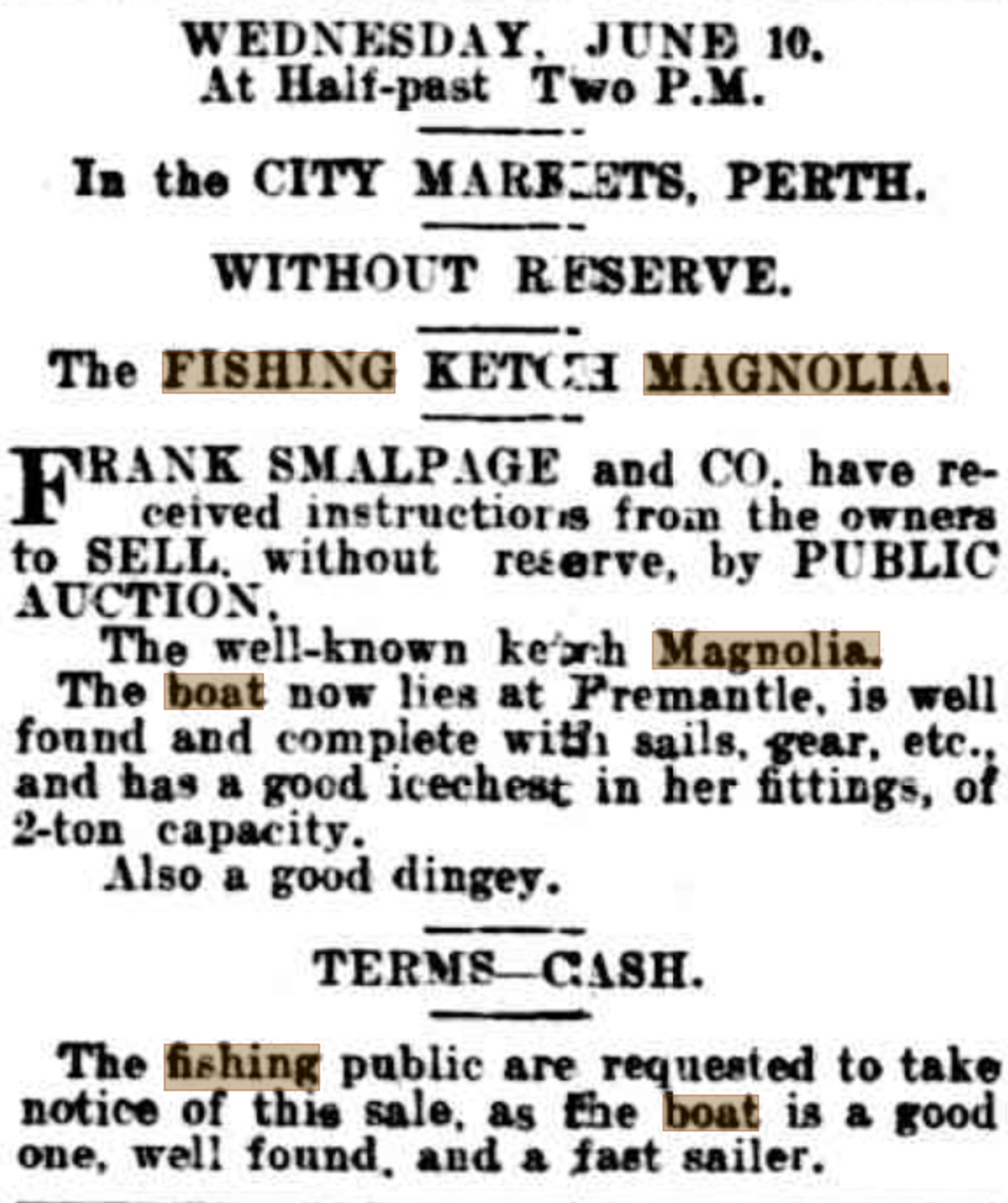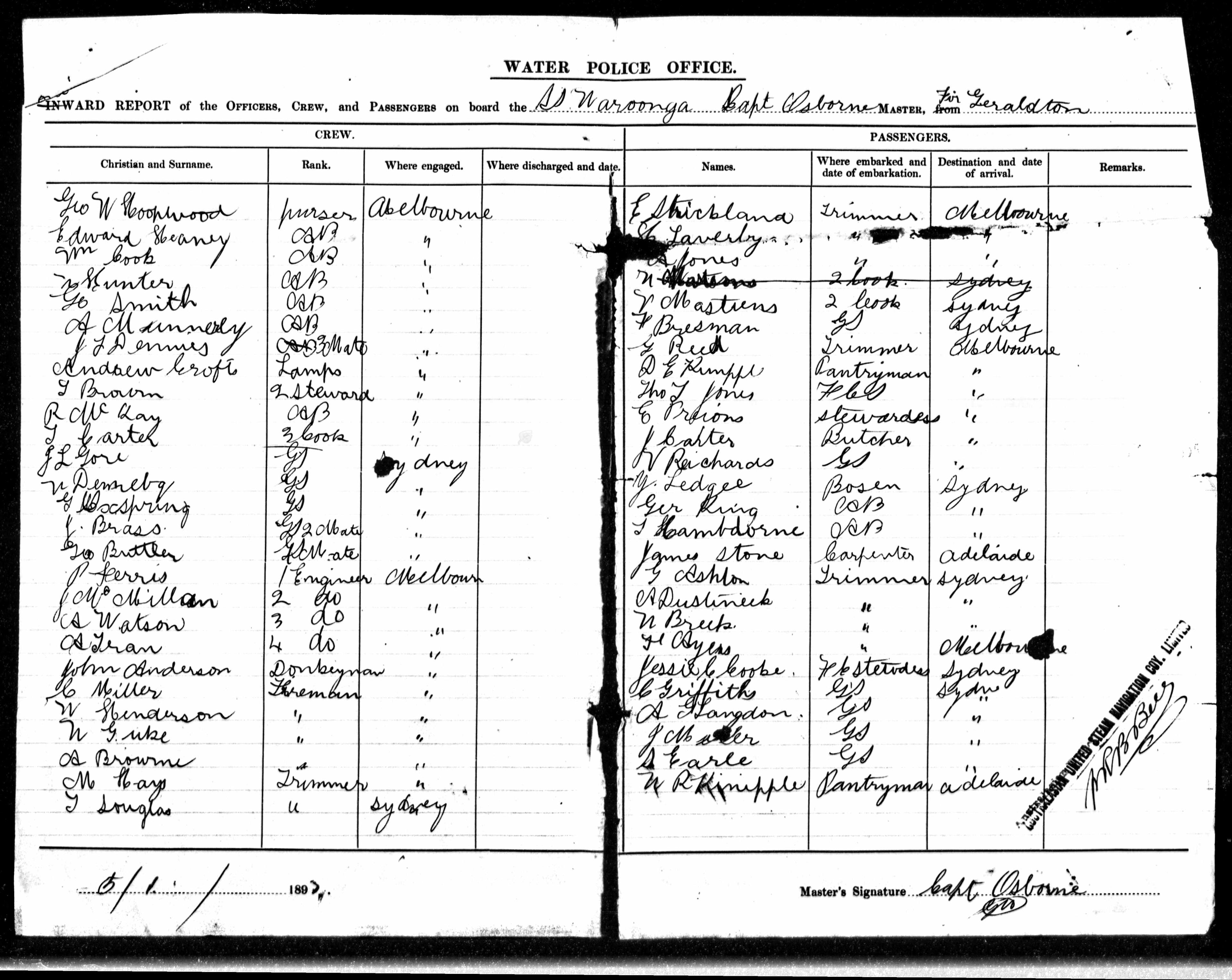John Anderson
Vessel Name: Magnolia
John Anderson
Drowned in Geraldton harbour; body recovered
12 April 1903

Magnolia

1903 Auction

Melbourne to Geraldton
John Anderson was born in Sweden in 1877. He appears to have arrived in Geraldton in 1897 by working as a donkeyman [engine room seaman] aboard the steamship Wahroonga from Melbourne. No records of marriage or family have been found to date. At the age of 26 years, he was the cook and crew member on the fishing vessel Magnolia, part of the fishing fleet based in Geraldton that fished the Geraldton, the Abrolhos Islands and Shark Bay wet lining areas.
Her crew and locals called the boat Maggie, a nickname that appears to have stuck throughout her fishing career.
Magnolia was shipped to New South Wales from England in 1898, and built at Hobson Bay, where she became a renowned racing vessel. She was 58 feet [17.6 metres] in length and 12 ft 6 in [3.81 metres] across her beam.
In 1900 her owner Louis Ehlert sent her to Harry Wilson & Co. in Fremantle where she was fitted for pearling in Cossack and Broome. With a 10ft 6inch [3.2 metres] draft she was unsuited to the Northwest tides.
In 1902 she was bought by Richard Septimus Haynes, MLC and fitted for wet lining in the Abrolhos Islands fishing grounds. She was sent to Geraldton and rented to the fishing crew on a share basis. She had an ice box that could carry two tons of ice to keep her catch fresh, and she was ketch-rigged in the style of line fishing vessels of the day.
In June 1903 Magnolia was auctioned by Frank Smalpage & Co. at the city fish market. She was purchased by Fremantle based company Winter, Brandt & Co. who had a branch office [and opened an ice factory] in Geraldton.Maggie had finally found a permanent home, based in Geraldton. As part of the Geraldton fleet, she fished Geraldton, the Abrolhos Islands and Shark Bay waters throughout the next 30 years.
Maggie’s cook John Anderson was last seen in Geraldton by her skipper Charlie [Charles] Nystrom and fellow crew member John Nelson on 8 April 1903, intoxicated and very much alive.
On 9 April John’s cap was handed to Charlie and John Nelson by George Cripps of the fishing boat Ada. He had found it on the railway jetty.It seems John had been to the railway jetty where Maggie was tied up, but he was not aboard, and the crew could not find him in town.
As the harbour was being dragged at the time, and it was thought that if John had drowned his body would be discovered during the dragging process. When he was not found it was assumed he had gone away to take a break somewhere and would return for work.
On 12 April Louis Haffner was walking along the beach when he saw John’s body floating in the water, fully clothed, minus his cap.
Dr Elliott completed an autopsy the same day and testified John had been in the water “more than 48 hours, but less than one week”. It is possible easterly winds caused the body to drift towards Point Moore, and the northeast wind on 12 April brought it back to the beach. John’s body was identified by Police Constable Evenson.
The inquest was commenced on at the Geraldton hospital on 12 April, with Dr Elliott’s findings, and adjourned to await the coroner’s report. John was buried on 13 April at the Apex Park Pioneer Cemetery in Geraldton.
The coroner agreed with the autopsy there were no signs of foul play. John fell from the railway jetty steps while attempting to board Magnolia. The railway jetty had steep concrete steps without railings and could be slippery from algae and seaweed. During the inquest, the coroner voiced his surprise that drownings were not more common.On 20 April he made a verdict of “found drowned”.
Aside from losing her cook, 1903 was a year of many incidents for both boat and crew. At the end of 1902 the owner-partners decided to dissolve their company. Two partners created a new company and bought the assets of the original company at auction. The exiting partner felt he was unfairly paid, and the dispute wound its way into the Supreme Court. The complicated case had multiple adjournments over the next six months with disagreements bogged in the complicated share fishing agreements.
In December 1903 a strong easterly wind caused Magnolia to drag her anchors in Geraldton harbour. She crashed into the jetty and damaged her stern and underwent significant repairs.
Skipper Charlie Nystrom had his own problems in 1903. On 6 March Magnolia moored in her home port of Geraldton and the next day Charlie cashed the drafts from the sale of the catch. On his way to pay his crew he was sidetracked by his mate John Pascoe and went for drinks in the Railway Hotel. That afternoon the crew found him asleep in the bar with no money. Charlie went to the police station to report the theft of his money, and barmaid Mary Ellen McDermott was arrested and charged with theft. The Geraldton court dismissed the case when a jury found John had given Mary money while intoxicated.
Magnolia maintained a reputation as a consistently high-catching boat until 19 March 1938 when she met her end on the reef at Red Bluff, 100.6 miles [162 kms] north of Carnarvon. The crew of Geraldton locals – Rolf Ottersen, Emil Luoma and John Akerstrom – remained with her until she broke up, then escaped in their dinghy with the sails and gear they managed to save. They lost their 900 lb [408 kgs] catch.
Maggie was valued at £800 and was uninsured. At that time insurance companies declined to accept the high risk for fishing boats. Although she was a well-known boat, there is no record of official registration in Western Australia. Her loss was felt by her crew and the fleet for her contribution to the overall catch of the midwest.
Magnolia was declared a historic wreck site in 2013. Her fastenings were salvaged by Carnarvon local Bruce Teede and are in the Fremantle Maritime Museum. Maggie’s wreck was reported by Peter Fox in 1980 to be located approximately nine kilometres south of Gnaraloo station homestead. Peter delivered salvaged brass bolts and pieces of wreckage to the Museum. An inspection team recovered some other parts.
